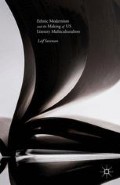Abstract
Sorensen argues that Américo Paredes’s George Washington Gómez dramatizes the failures of two discourses of subject formation (the corrido and the bildungsroman) that have become central to narratives of Chicana/o literary history. He traces the protagonist’s progress through the novel as a series of negotiations with these two narratives of subject formation and reads the novel’s confounding ending as a comment on the failures of both centrist and alternative discourses of modernity. This critique not only exposes the constraints of the world of the novel but also calls into question the mode of literary history that would later recover it. The aesthetic failures of the corrido and the bildungsroman are directly linked to the failure of the protagonist to become a unified subject.
Access this chapter
Tax calculation will be finalised at checkout
Purchases are for personal use only
Notes
- 1.
For explorations of subject formation, see María Josefina Saldaña-Portillo “‘Wavering on the Horizon of Social Being’: The Treaty of Guadalupe-Hidalgo and the Legacy of Its Racial Character in Américo Paredes’s George Washington Gómez,” Radical History Review 89 (winter 2004): 135–164, Louis Gerard Mendoza, Historia: The Literary Making of Chicano & Chicana History (College Station: Texas A&M University Press, 2001) 143–160; Ramón Saldívar, “The Borderlands of Culture: Américo Paredes’s George Washington Gómez and Chicano Literature at the End of the Twentieth Century” American Literary History 5 (summer 1993): 272–293; and José David Saldívar “Américo Paredes and Decolonization,” in Cultures of United States Imperialism, eds. Amy Kaplan and Donald Pease (Durham: Duke University Press, 1993), 292–311.
- 2.
According to Paredes, the “corrido century” stretches from 1836 to the late 1930s (“With His Pistol in His Hand”: A Border Ballad and its Hero [Austin: University of Texas Press, 1958]). Ramón Saldívar, Teresa McKenna, and José David Saldívar argue for the corrido’s paradigmatic status in, respectively, Chicano Narrative: The Dialectics of Difference (Madison: University of Wisconsin Press, 1990), 32; “On Chicano Poetry and the Political Age: Corridos as Social Drama,” in Criticism in the Borderlands, eds. Héctor Calderón and José David Saldívar (Durham: Duke University Press, 1991), 183; and “Towards a Chicano Poetics: The Making of the Chicano Subject, 1969–1982,” Confluencia 1.2 (1986): 13.
- 3.
Franco Moretti describes this function of the bildungsroman in The Way of the World: The Bildungsroman in European Culture, trans. Albert Sbragia (New York: Verso, 2000).
- 4.
Lupe is modeled on Simón García, a character in “El Corrido de José Mosqueda.” Paredes discusses García in “José Mosqueda and the Folklorization of Actual Events,” in Folklore and Culture on the Texas-Mexican Border, ed. Richard Bauman (Austin: CMAS Books, 1993), 177–214.
- 5.
For an account of the seditionist uprising, see David Montejano, Anglos and Mexicans in the Making of Texas, 1836–1986 (Austin: University of Texas Press, 1987), 117.
- 6.
Américo Paredes, George Washington Gómez (Houston: Arte Público Press, 1989), 281. Henceforth cited parenthetically as GWG.
- 7.
See José Limón’s account of Paredes’s scholarship’s influence on the Chicano movement in “The Return of the Mexican Ballad: Américo Paredes and His Anthropological Text as Persuasive Political Performances,” in Creativity/Anthropology, eds. Smadar Lavie, Kirin Narayan and Renato Rosaldo (Ithaca: Cornell University Press, 1993), 184–210.
- 8.
See my “The Anti-corrido of George Washington Gómez: A Narrative of Emergent Subject Formation,” American Literature 80.1 (March 2008): 111–40.
- 9.
In Chap. 6 I further discuss how Paredes’s scholarly work has anachronistically provided the horizon of interpretation for his earlier fiction.
- 10.
Saldaña-Portillo, “Wavering on the Horizon of Social Being,” 142.
- 11.
Benedict Anderson describes the role print culture played in new world nationalisms in Imagined Communities (New York: Verso Press, 1991), 161–165.
- 12.
Louis Althusser, “Ideology and Ideological State Apparatuses,” Lenin and Philosophy and Other Essays, trans. Ben Brewster (New York: Monthly Review Press, 1971), 127–188. The promise and limitations of Althusser’s model of interpellation are demonstrated in Judith Butler’s “‘Conscience Doth Make Subjects of Us All’: Althusser’s Subjection” in The Psychic Life of Power: Theories of Subjection (Stanford: Stanford University Press, 1997), 106–131 and José Esteban Muñoz’s introduction to Disidentifications: Queers of Color and the Performance of Politics (Minneapolis: University of Minnesota Press, 1999), 1–34.
- 13.
See her reading of a moment in which a Chicano delegation to the EZLN (the Ejército Zapatista de Liberación Nacional) in Chiapas identified themselves as “los indios del norte” (“Wavering,” 140).
- 14.
Paredes, “With His Pistol in His Hand,” 8–10. Carl Gutiérrez-Jones analyzes Paredes’s imagination of the pre-1848 border in Rethinking the Borderlands (Berkeley: University of California Press, 1995), 103–105.
- 15.
David Montejano, Anglos and Mexicans in the Making of Texas, 1836–1986 (Austin: University of Texas Press, 1987), 106–178.
- 16.
Paredes’s representation of a corrido character as an unsympathetic outlaw echoes Jovita González de Mireles’s depiction of corrido heroes as self-indulgent adventurers in her historical novel Caballero. I develop this comparison further in Chap. 6.
- 17.
For the version that Paredes collected, see A Texas-Mexican Cancionero (Austin: University of Texas Press, 1995), 69–71.
- 18.
Christopher Schedler, Border Modernism: Intercultural Readings in American Literary Modernism (New York: Routledge, 2002), 246.
- 19.
Here I am drawing on Agamben’s critique of the belief “that will has power over potentiality” (“Bartelby, or On Contingency,” Potentialities, 254).
- 20.
Manuel M. Martín-Rodriguez, “Textual and Land Reclamations: The Critical Reception of Early Chicana/o Literature,” in Recovering the U.S. Hispanic Literary Heritage, Vol. II, eds. Erlinda Gonzales-Berry and Chuck Tatum (Houston: Arte Público Press, 1996), 40–58.
Author information
Authors and Affiliations
Copyright information
© 2016 Palgrave Macmillan, a division of Nature America Inc.
About this chapter
Cite this chapter
Sorensen, L. (2016). 4 Impossible Authorship. In: Ethnic Modernism and the Making of US Literary Multiculturalism. Palgrave Macmillan, New York. https://doi.org/10.1057/978-1-137-57019-2_5
Download citation
DOI: https://doi.org/10.1057/978-1-137-57019-2_5
Published:
Publisher Name: Palgrave Macmillan, New York
Print ISBN: 978-1-137-58476-2
Online ISBN: 978-1-137-57019-2
eBook Packages: Literature, Cultural and Media StudiesLiterature, Cultural and Media Studies (R0)

